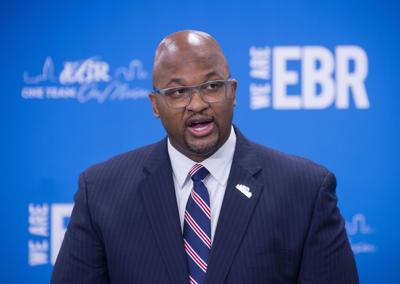The East Baton Rouge Parish School Board recently settled on nine performance goals for Supt. Sito Narcisse that, if met, would earn him up to $10,000 on top of his annual $255,000 annual salary.
Narcisse, however, has not been on the job long enough for the board to judge whether he has met many of the goals.
In approving , the board set a deadline of Dec. 31 for board members to decide which goals Narcisse met during 2021 and which ones he hasn’t. That’s the same deadline for the board to complete its first annual evaluation of Narcisse.
The board plans to take up his evaluation at its Dec. 16 meeting.
After a swift backlash, newly appointed East Baton Rouge Parish schools Superintendent Sito Narcisse pulled back Thursday from an immediate sh…
Deciding on performance pay, however, looks like it will be put off.
Gwynn Shamlin, general counsel for the school, said on Friday that Narcisse is planning to ask the board to postpone its review of those nine performance goals until a later date.
“He wants it to be thorough,” Shamlin said. “He’s going to be waiving the performance standards.”
, approved when he was hired in January, calls for him to be evaluated for his work every calendar year. By contrast, his predecessors were evaluated based on their work for each school year, which normally ends in late May.
Each performance goal met is worth an extra $1,111.
Of the nine new goals, four rely on academic data that is typically not available until the end of the school year, often not until months later.Â
Three of the goals are: Increasing the number of students taking college-level courses, like advanced placement and dual enrollment; growing ACT scores; and increasing teacher effectiveness as measured through the district's performance evaluations.
One of the goals has three parts: Growing LEAP scores, increasing graduation rates and increasing the number of 8th and 9th graders who are on track or ahead of schedule to graduate on time.
None of these four goals set specific targets for improvement. They simply need to “increase” by some amount for Narcisse to meet them.
Three more goals are already accomplished:
- Submitting a “balanced budget” for the 2021-22 fiscal year, which began July 1, as well as submitting monthly reports on spending and revenue.
- Implementing the “100 Day Entry Plan” that Narcisse brought with him when he was hired in January.
- Leading the effort to create a new strategic plan for the school system, which was approved in July, and then implement it, complete with an annual report on how well the plan is working.
Another goal, to develop and implement a facilities plan for the school system, is under way, with a final plan scheduled for approval in June.
A speedy effort to come up with a new strategic plan for the East Baton Rouge Parish school system races to a conclusion this week with town h…
The final goal is also a work in progress and it deals with .
It calls for Narcisse to show progress in two out of four general areas laid out in that plan: student achievement, customer service, operations and personnel. Each area, or “commitment,” comes with measurements: 10 for student achievement and five each for the other three areas. Each measure generally calls for annual improvement of three to five percentage points.
Eleven of these 20 measures, or however, remain blank because they still lack baseline information by which to gauge whether they are being met.
The coronavirus pandemic also means that some relevant school data is either missing or the consequences associated with the data have been waived by state and federal officials. For instance, the state issued its last school letter grades in fall 2019. On Friday, the state released “simulated” school performance scores for school districts across the state but did not issue new letter grades.
Shamlin said he started drawing up possible performance goals for Narcisse in September.
Narcisse said he wants the strategic plan to be central to any evaluation of how he’s doing.
“What’s important for me is that measures of my performance be based on our strategic plan,” Narcisse said.
Board President David Tatman, who has worked with three superintendents to develop performance goals, said some of the ones Narcisse has are new, but some appear year after year.
“Some of them are what I would refer to as perennial goals, because that’s what we do,” Tatman said.
Some goals are also there because they are required by law. have to have “performance objectives” in their employment contracts and that the objectives must deal with student achievement, graduation rates and teacher effectiveness.
The law, however, also calls for superintendents to meet special targets for improving student achievement and graduation rates at any schools they have with C, D or F academic letter grades. None of the nine goals, or the strategic plan, mention schools with low letter grades or set any targets for their improvement.
At last count, in 2019, the school system had only 18 out of 75 schools with a letter grade of an A or B. Of the rest, 27 schools had a D or an F.
In response to questions from The Advocate, Shamlin said Friday he is awaiting fresh legal guidance from outside counsel on whether the nine goals as written are sufficient to comply with the 2012 law.
Former Superintendent Warren Drake had to “decrease (the district’s) number of D and F schools” and to increase the school performance scores of C schools while making sure B and A schools didn’t slip.
As part of that goal, Drake was obliged to develop “targeted intervention” for at least three D or F schools and that schools would show 5 points of growth in their annual performance score. Drake ended up creating an Innovation Network of the district’s lowest performing schools; Narcisse has shifted mostly to districtwide improvement efforts.
The East Baton Rouge Parish School Board on Thursday unanimously rehired Warren Drake to serve as its superintendent for two more years, but n…
Drake’s goal for “targeted intervention” came about largely due to the strong lobbying by parents affiliated with the pro-school choice education reform group, Stand For Children. That group was at odds at times with Drake but has been a consistent supporter of Narcisse and many of his initiatives.
In an interview, Carrie Griffin Monica, executive director of Stand For Children Louisiana, said the new strategic plan, if followed, will do a lot for all schools, including low performing schools. So she sees less urgency in setting specific goals for those schools.
She noted the strategic plan now calls for the school district to increase the number of second-graders reading at or above grade level by three to five percentage points annually, and it calls for similar improvements in English and math performance in grades three to eight.
“I think it’s really encouraging that we are encouraging growth for all schools. Growth doesn’t stop, even for A-rated schools,” Monica said.






